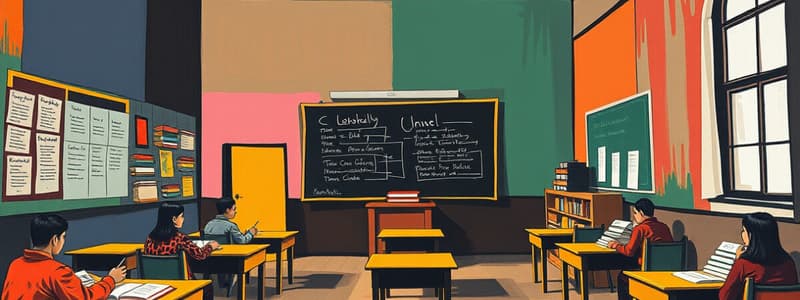Podcast
Questions and Answers
What primarily differentiates constructivist learning from traditional learning methods?
What primarily differentiates constructivist learning from traditional learning methods?
- Emphasis on memorization of facts.
- Heavy reliance on textbooks and lectures.
- Active involvement of students in their learning process. (correct)
- The use of standardized testing.
Which aspect is critical to the constructivist approach in mathematics education?
Which aspect is critical to the constructivist approach in mathematics education?
- Focusing solely on assessments to gauge understanding.
- Following strict guidelines provided by textbooks.
- Memorizing mathematical procedures.
- Building on previously learned concepts. (correct)
What role does the teacher play in a constructivist classroom according to constructivist theory?
What role does the teacher play in a constructivist classroom according to constructivist theory?
- An assessor who primarily evaluates student performance.
- An observer who does not interact with students.
- A source of all knowledge and authority.
- A facilitator who guides students in constructing their understanding. (correct)
Which of the following is NOT a characteristic of constructivist teaching as identified by Brooks & Brooks?
Which of the following is NOT a characteristic of constructivist teaching as identified by Brooks & Brooks?
Who conceptualized the constructivist learning theory discussed in this content?
Who conceptualized the constructivist learning theory discussed in this content?
What is a primary focus of the constructivist approach in mathematics education according to the content?
What is a primary focus of the constructivist approach in mathematics education according to the content?
In constructivist theory, knowledge is primarily viewed as:
In constructivist theory, knowledge is primarily viewed as:
What is a key element of math as a subject that complements the constructivist approach?
What is a key element of math as a subject that complements the constructivist approach?
According to the content, how is knowledge constructed in a constructivist learning environment?
According to the content, how is knowledge constructed in a constructivist learning environment?
Which of the following is an implication of the constructivist approach for teaching mathematics?
Which of the following is an implication of the constructivist approach for teaching mathematics?
Flashcards are hidden until you start studying
Study Notes
Comparison of Classroom Models
- Traditional classroom curriculum starts with basic skills, focusing on the parts of the whole.
- In contrast, constructivist classroom curriculum emphasizes big concepts, beginning with the whole and expanding to its parts.
- Teachers in traditional settings disseminate information, positioning students as passive recipients of knowledge.
- Constructivist teachers engage in dialogue with students, facilitating the construction of knowledge.
- Student roles in a traditional classroom are primarily solitary, while in constructivist settings, students predominantly work in groups.
Characteristics of Constructivist Teachers
- Foster leadership, cooperation, and the presentation of ideas among students.
- Adapt instructional strategies based on students’ thoughts, experiences, and interests.
- Utilize printed materials and experts to enhance learning and information availability.
- Promote open discussions to introduce new ideas and encourage questions and answers.
- Invite students to predict causes and effects related to specific events and cases.
- Assist students in testing and refining their ideas.
- Present ideas and instructional materials only after inviting students' perspectives.
- Challenge and encourage students to critically examine the concepts and ideas of others.
- Implement cooperative teaching grounded in student interactions, respect, idea-sharing, and collaborative learning tasks.
- Inspire students to value and incorporate other people’s ideas.
Constructivist Learning Theory in Education
- Constructivist theory highlights learning as an active process where students create meaning from experiences.
- Outcomes are achieved best when students independently seek to make sense of concepts, with teachers acting as guides.
- The Department of Education emphasizes this theory as foundational in curriculum design, indicating that knowledge is constructed through integration of personal experiences with new information.
- This approach is effectively applied in teaching mathematics, where learning is cumulative and builds on previous knowledge.
Origins and Application of Constructivism
- Educational theorist Jean Piaget conceptualized constructivism, emphasizing experiential learning in children rather than rote instruction.
- Piaget posited that children learn best through active engagement with their environment.
- Constructivist approaches in mathematics education utilize vertical structure, allowing students to build on previously acquired knowledge effectively.
- Key characteristics of constructivist teaching include fostering student inquiries and encouraging the acceptance of their invented ideas.
Studying That Suits You
Use AI to generate personalized quizzes and flashcards to suit your learning preferences.




